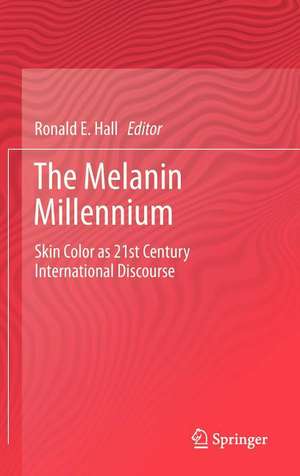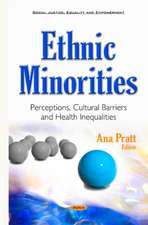The Melanin Millennium: Skin Color as 21st Century International Discourse
Editat de Ronald E. Hallen Limba Engleză Hardback – 11 sep 2012
This volume addresses the issue of skin color in a worldwide context. A virtual visit to countries that have witnessed a huge rise in the use of skin whitening products and facial feature surgeries aiming for a more Caucasian-like appearance will be taken into account. The book also addresses the question of whether using the laws has helped to redress injustices of skin color discrimination, or only further promoted recognition of its divisiveness among people of color and Whites.
The Melanin Millennium has to do with now and the future. In the 20th century science including eugenics was given to and dominated by discussions of race category. Heretofore there remain social scientists and other relative to the issue of skin color loyal to race discourse. However in their interpretation and analysis of social phenomena the world has moved on. Thus while race dominated the 20th century the 21st century will emerge as a global community dominated by skin color and making it the melanin millennium.
| Toate formatele și edițiile | Preț | Express |
|---|---|---|
| Paperback (1) | 941.12 lei 38-44 zile | |
| SPRINGER NETHERLANDS – 15 oct 2014 | 941.12 lei 38-44 zile | |
| Hardback (1) | 951.55 lei 38-44 zile | |
| SPRINGER NETHERLANDS – 11 sep 2012 | 951.55 lei 38-44 zile |
Preț: 951.55 lei
Preț vechi: 1252.04 lei
-24% Nou
Puncte Express: 1427
Preț estimativ în valută:
182.10€ • 189.42$ • 150.34£
182.10€ • 189.42$ • 150.34£
Carte tipărită la comandă
Livrare economică 10-16 aprilie
Preluare comenzi: 021 569.72.76
Specificații
ISBN-13: 9789400746077
ISBN-10: 9400746075
Pagini: 364
Ilustrații: XIV, 350 p.
Dimensiuni: 155 x 235 x 28 mm
Greutate: 0.69 kg
Ediția:2013
Editura: SPRINGER NETHERLANDS
Colecția Springer
Locul publicării:Dordrecht, Netherlands
ISBN-10: 9400746075
Pagini: 364
Ilustrații: XIV, 350 p.
Dimensiuni: 155 x 235 x 28 mm
Greutate: 0.69 kg
Ediția:2013
Editura: SPRINGER NETHERLANDS
Colecția Springer
Locul publicării:Dordrecht, Netherlands
Public țintă
ResearchCuprins
Preface.- Chapter 1. The Bleaching Syndrome: Western Civilization vis-à-vis Inferiorized People of Color; Ronald E. Hall.- Chapter 2. The Historical and Cultural Influences of Skin Bleaching in Tanzania.- Kelly M. Lewis; Solette Harris; Christina Champ; Willbrord Kalala; Will Jones; Kecia L. Ellick; Justie Huff and Sinead Younge.- Chapter 3. Pathophysiology and Psychopathology of Skin Bleaching and Implicationa of Skin Colour in Africa; A.A. Olowu and O. Ogunlade.- Chapter 4. An Introduction to Japanese Society's Attitudes Toward Race and Skin Color; Arudou Debito.- Chapter 5. The Inconvenient Truth of India, Caste, and Color Discrimination; Varsha Ayyar and Lalit Khandare.- Chapter 6. Indigeneity on Guahan: Skin Color as a Measure of Decolonization; LisaLinda Natividad.- Chapter 7. A Table of Two Cultures; Eneid Routté-Gómez.- Chapter 8. Where are you From?; Stéphanie Cassilde.- Chapter 9. Social Work Futures: Reflections from the UK on the Demise of Anti-racist Social Work and Emerging Issues in a ''Post-Race'' Era; Mekada J. Graham.- Chapter 10. Shades of Conciousness: From Jamaica to the UK; William Henry; Chapter 11. Fanon Revisited: Race Gender and Colniality vis-à-vis Skin Color; Linda Lane and Hauwa Mahdi.- Chapter 12. Pigment Disorders and Pigment Manipulations; Henk E. Menke.- Chapter 13. Skin Color and Blood Quantum: Getting the Red Out; Deb Bakken and Karen Branden.- Chapter 14. The Impact of Skin Color on Mental and Behavorial Health in African American and Latina Adolescent Girls: A Review of the Literature; Alfiee M. Breland-Noble.- Chapter 15. Characteristics of Color Discrimination Charges Filed with the EEOC; Joni Hersch.- Chapter 16. The Consequences of Colorism; Margaret Hunter.- Chapter 17. Navigating the Color Complex: How Multiracial Individuals Narrate the Elements of Appearance and Dynamics of Color in Twenty-first Century America; Sara McDonough and David L. Brunsma.- Chapter 18. The Fade-Out of Shirley, a Once-UltimateNorm: Colour Balance, Image Technologies, and Cognitive Equity; Lorna Roth.- Chapter 19. What Color is Red? Exploring the implications of Phenotype for Native Americans; Hilary N. Weaver.- Chapter 20. From Fair & Lovely to Banho de Lua: Skin Whitening and its Implications in the Multi-ethnic and Multicolored Surinamese Society; Jack Menke.- Chapter 21. Affirmative Action and Racial Identityin Brazil: A Study of the First Quota Graduates at the State University of Rio de Janneiro: Vânia Penha-Lopes.-
Notă biografică
After graduating with distinction, Dr. Hall’s professional career began as a clinical social worker. His professional role encompassed the practice of individual and group psychotherapy with schizophrenic and manic-depressive clients. Subsequent to numerous clinical observations, Dr. Hall incorporated the notion of skin color, among people of color, as a critical dynamic of mental health. Having written his dissertation on skin color, in 1990 Dr. Hall testified as expert witness to America’s first skin color discrimination case between African Americans: Morrow vs. IRS. Dr. Hall later devised the Bleaching Syndrome to explain discrimination among people of color and Identity Across the Lifespan as an alternative biracial identity model. Dr. Hall’s work includes over 150 (co)authored publications, interviews, and presentations on these topics including Justice Clarence Thomas and President Barack Obama via TIME magazine and Oprah Winfrey via The Color Complex. His previous book is titled: An Historical Analysis of Skin Color Discrimination in America (2010). His most recent is titled: Rooming in the Master’s House: Power and Privilege in the Rise of Black Conservatism (2010). Dr. Hall’s has lectured on skin color both locally and internationally including the U.S. Congress and Oxford University. His most recent event took place in Suriname, South America in November of 2010 where he was the keynote for a medical convention. There Dr. Hall advised an organization of European doctors of the Bleaching Syndrome. Dr. Hall is associated with numerous professional organizations including the National Association of Social Workers, the National Association of Black Social Workers, the Michigan Association of Black Social Workers, and the Council on Social Work Education.
Textul de pe ultima copertă
In the aftermath of the 60s “Black is Beautiful” movement and publication of The Color Complex almost thirty years later the issue of skin color has mushroomed onto the world stage of social science. Such visibility has inspired publication of the Melanin Millennium for insuring that the discourse on skin color meet the highest standards of accuracy and objective investigation.
This volume addresses the issue of skin color in a worldwide context. A virtual visit to countries that have witnessed a huge rise in the use of skin whitening products and facial feature surgeries aiming for a more Caucasian-like appearance will be taken into account. The book also addresses the question of whether using the laws has helped to redress injustices of skin color discrimination, or only further promoted recognition of its divisiveness among people of color and Whites.
The Melanin Millennium has to do with now and the future. In the 20th century science including eugenics was given to and dominated by discussions of race category. Heretofore there remain social scientists and other relative to the issue of skin color loyal to race discourse. However in their interpretation and analysis of social phenomena the world has moved on. Thus while race dominated the 20th century the 21st century will emerge as a global community dominated by skin color and making it the melanin millennium.
This volume addresses the issue of skin color in a worldwide context. A virtual visit to countries that have witnessed a huge rise in the use of skin whitening products and facial feature surgeries aiming for a more Caucasian-like appearance will be taken into account. The book also addresses the question of whether using the laws has helped to redress injustices of skin color discrimination, or only further promoted recognition of its divisiveness among people of color and Whites.
The Melanin Millennium has to do with now and the future. In the 20th century science including eugenics was given to and dominated by discussions of race category. Heretofore there remain social scientists and other relative to the issue of skin color loyal to race discourse. However in their interpretation and analysis of social phenomena the world has moved on. Thus while race dominated the 20th century the 21st century will emerge as a global community dominated by skin color and making it the melanin millennium.
Caracteristici
Addresses the issue of skin color in a worldwide context Discusses the introduction of new forms of visual media and their effect on skin color discrimination Touches up on the issue of skin bleaching and the Bleaching Syndrome







